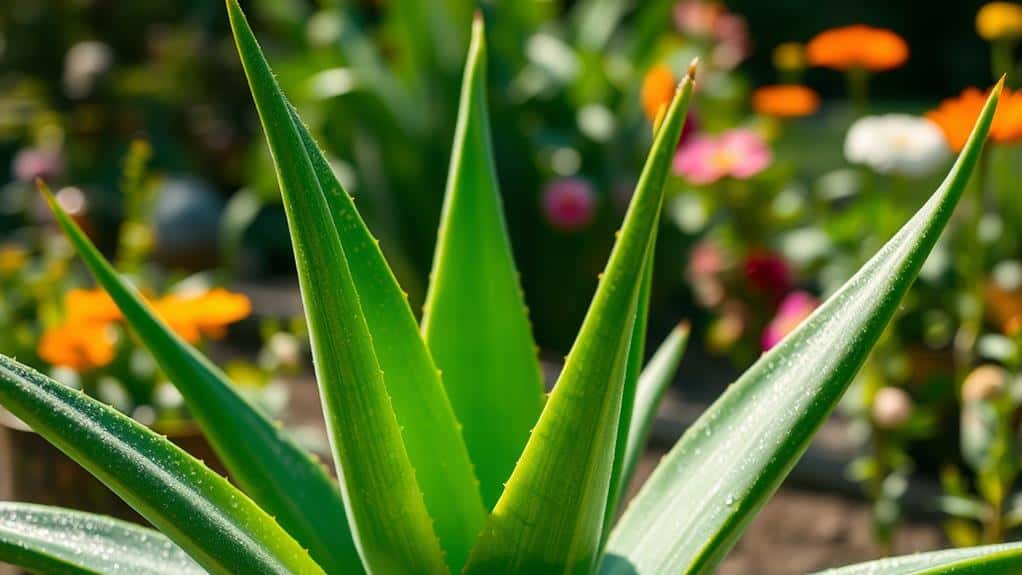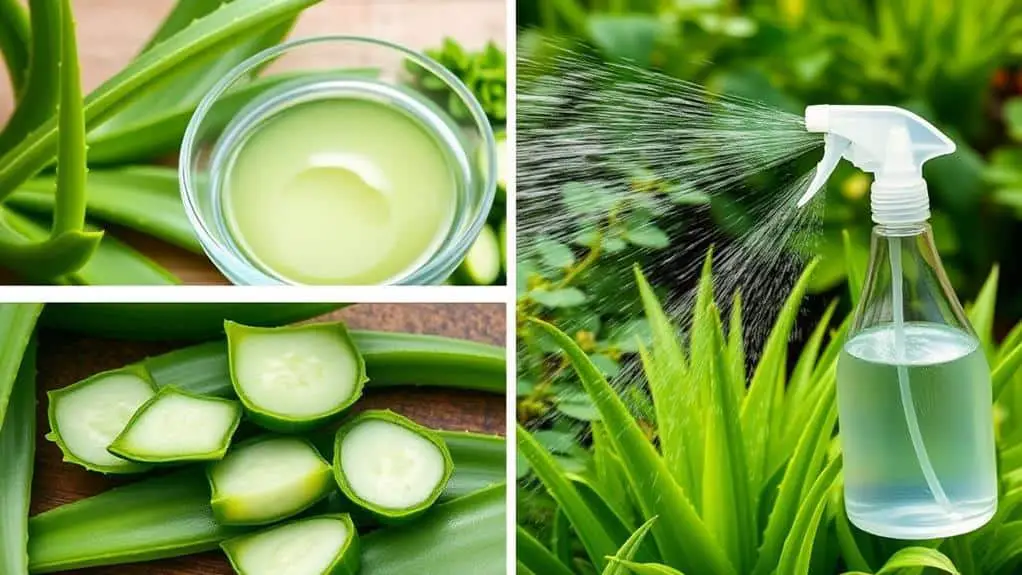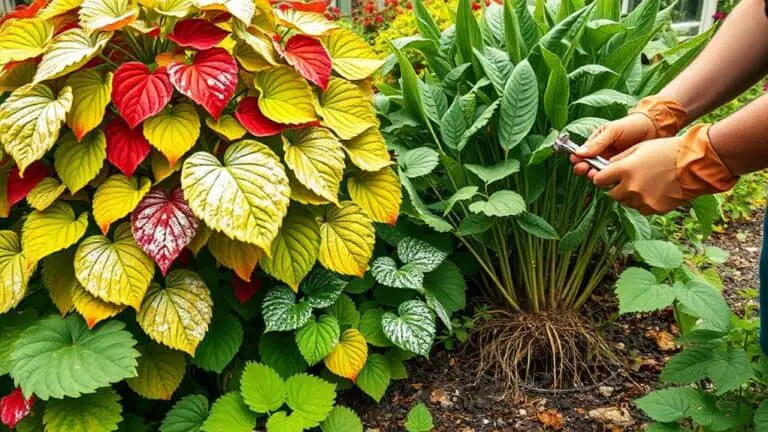How To Make And Use Aloe Vera Foliar Spray
When I first started using aloe vera foliar spray, I was amazed at the benefits it brought to my plants. If you've ever wondered how to make this simple yet effective solution, you'll find the process straightforward and rewarding. Selecting the right aloe vera and preparing it correctly are essential steps, and I'll guide you through each one. Once you understand these basics, your plants will thrive like never before. Let's explore the materials and techniques you'll need to get started, ensuring you make the most of this natural remedy.
Understanding Aloe Vera

Understanding Aloe Vera begins with recognizing its incredible versatility and nutrient-rich composition.
It's amazing how Aloe Vera, especially the Aloe barbadensis variety, contains over 75 beneficial compounds like amino acids, vitamins, and antioxidants.
The gel inside the leaves is rich in salicylic acid, acting as a natural rooting hormone. This promotes root development and helps plants resist stress and disease.
When you make a foliar spray using aloe vera gel, you're applying a natural biostimulant that enhances soil health by boosting microbial activity and improving nutrient absorption.
This makes Aloe Vera perfect for organic gardening.
With its ability to thrive in warm, dry climates and requiring minimal watering, it's an excellent choice for diverse gardening environments.
Benefits for Plants
Recognizing Aloe Vera's incredible versatility, let's explore how its nutrient-packed gel benefits plants.
Aloe vera foliar spray enhances nutrient absorption by delivering essential micronutrients directly to the leaves, promoting overall plant health and vigor. This helps plants get what they need more efficiently.
The salicylic acid in aloe vera acts as a natural biostimulant, aiding in stress resistance against heat and pests. This improves the plant's resilience.
Regularly using aloe vera foliar spray can boost photosynthesis, leading to faster growth and better yields. Its antifungal properties protect plants from diseases, promoting healthier foliage.
Additionally, aloe vera encourages beneficial microorganisms in the soil, enhancing root development and natural rooting. This improves the soil health and nutrient cycling.
Selecting the Right Aloe Vera

When choosing aloe vera for your foliar spray, it's vital to select the Aloe barbadensis variety due to its high nutrient content and medicinal properties.
Look for mature, thick, and firm aloe vera leaves that are free from blemishes or disease signs. This guarantees you're getting the most beneficial compounds for your plants.
For the best results, follow these guidelines:
- Choose mature leaves: These have the highest nutrient concentration.
- Opt for organic gardening: Confirm the leaves come from organically grown plants to avoid harmful chemicals.
- Use fresh leaves: Harvest and use the leaves within 30 minutes to retain peak nutrients.
Selecting the right aloe vera is significant for making an effective foliar spray. Following these tips will set you up for success!
Gathering Materials
To get started on making your aloe vera foliar spray, you'll need to gather a few essential materials.
First, you'll need 1/4 cup of fresh aloe gel from the inner leaves. Be sure to avoid the skin to prevent clogging in your sprayer.
Next, have 1 gallon of clean water ready for dilution. This is the recommended volume for effective application.
A blender or mixing tool is critical for thoroughly blending the aloe gel with water to create a homogeneous solution.
Additionally, pH test strips can verify your foliar spray has an ideal pH range of 6.5-6.8.
Optional ingredients like coconut water or neem extract can enhance nutrient delivery and pest control, making your spray even more effective.
Preparing Aloe Vera Gel

Now that we've gathered all the necessary materials, let's move on to preparing the aloe vera gel. Here's a quick guide to get you started:
- Select mature leaves: Choose Aloe barbadensis leaves for their high nutrients.
- Clean the leaves: Wash thoroughly to remove dirt and contaminants.
- Extract the gel: Slice open the leaves lengthwise and scoop out the clear gel, being careful to avoid the bitter green skin.
Once you've scooped out the aloe vera gel, blend it with water at a ratio of 1/4 cup of gel per gallon of water for your foliar spray.
If you have any leftover gel, store it in an airtight container in the refrigerator for up to a week.
Mixing the Foliar Spray
To mix your aloe vera foliar spray, start by extracting the gel from the inner leaf to guarantee it blends smoothly and delivers maximum nutrients.
Blend 1/4 cup of this fresh aloe gel with 1 gallon of water to create the perfect dilution.
Aloe Gel Extraction
Starting the aloe gel extraction process for your foliar spray is straightforward and rewarding. First, cut the outermost leaves of the Aloe Vera plant; they've the highest nutrient content.
Here's how to prepare your foliar spray:
- Blend: Scoop out the inner aloe gel and blend it with water. Use 1/4 cup of aloe gel for every gallon of water.
- Strain: Strain the mixture to remove solid particles to prevent clogging your sprayer.
- Apply Quickly: Use the spray within 15 minutes to maximize nutrient efficacy and avoid oxidation.
Make certain you adjust the pH of the solution to the ideal range of 6.5-6.8 for your plants. This guarantees they absorb the nutrients effectively.
Happy gardening!
Dilution Ratios
When mixing your aloe vera foliar spray, achieving the correct dilution ratios is essential for ideal plant health.
For a nutrient-rich foliar spray, combine 1/4 cup of fresh aloe with 1 gallon of water. This mix guarantees your plants get the nutrients they need. Be sure to adjust the pH to 6.5-6.8 to help plants absorb the nutrients better.
If you're using dry aloe vera powder, mix 1/8 teaspoon per 1 gallon of water. Remember to use only the inner gel of the aloe leaves to prevent clogging your spray equipment.
It's smart to test the foliar spray on a few plants first to make sure there are no adverse reactions. Happy gardening!
Application Techniques

A fine mist sprayer is your best friend when it comes to applying aloe vera foliar spray effectively. It guarantees even coverage on the leaf surfaces, which is essential for nutrient absorption.
Here are three key steps to follow:
- Prepare the spray: Blend 2 teaspoons of fresh aloe gel with 1 gallon of water. Use the mixture within 15 minutes to maintain nutrient potency.
- Adjust the pH: Confirm the spray's pH is between 6.5 and 6.8. This range helps your plants absorb nutrients better and prevents stress.
- Test first: Before applying widely, test the foliar spray on a few plants. Monitor for any adverse reactions and adjust if necessary.
These techniques will help you make the most of your aloe vera foliar spray.
Best Practices for Use
When using your aloe vera foliar spray, make sure to apply it every 7-14 days, adjusting the frequency based on how your plants respond.
Always test the spray on a less valuable plant first to check for any adverse reactions.
Also, keeping the pH between 6.5 and 6.8 is key for the best nutrient absorption, so your plants stay healthy and vibrant.
Proper Application Techniques
Ever wondered how to get the most out of your aloe vera foliar spray? Proper application techniques are key to enhancing plant health. Here's what I recommend:
- Mixing: Combine 2 teaspoons of fresh aloe gel with 1 gallon of water. Make certain to remove the skin to prevent clogging.
- Timing: Apply early in the morning or after sunset. This avoids sunburn and boosts absorption.
- Dilution and pH: Use a 1/4 cup of aloe water per gallon, adjusting the pH to 6.5-6.8.
Test the spray on a few plants first to verify there's no adverse reaction.
Using these tips, you'll see your plants thrive! Remember, consistency is key to reaping the benefits of your foliar spray.
Happy spraying!
Optimal Usage Frequency
Now that you know how to apply your aloe vera foliar spray effectively, let's talk about how often you should use it.
For ideal usage frequency, aim to apply your fresh aloe spray every 7 to 14 days. Keep a close eye on your plants to see how they respond. If you notice any adverse effects, consider reducing the frequency to bimonthly or even monthly.
Early morning or late afternoon is the best time for foliar spraying, as it helps minimize the risk of sunburn and improves absorption.
For new seedlings, start a few weeks after sprouting and continue monthly to avoid fertilizer burn. Stressed plants or high-demand varieties may benefit from weekly applications to support their health.
Monitoring Plant Health

Regularly monitoring your plant's health is essential to making the most out of aloe vera foliar sprays. By keeping an eye on your plant leaves, you can guarantee that your foliar sprays are effective.
Here are three key areas to focus on:
- Leaf Coloration and Texture: Look for vibrant green leaves with minimal spots or discoloration. Healthy leaves indicate good nutrient absorption.
- Growth Patterns and Vigor: Notice any increases in height or leaf production a few weeks after spraying. Improved growth suggests better nutrient uptake.
- Pest Activity or Disease: Check for signs of pests or disease, like wilting or unusual spots. Effective aloe vera applications can reduce pest presence and boost plant resilience.
Troubleshooting Common Issues
When using aloe vera foliar spray, it's important to avoid common mistakes like clogging your sprayer or applying at the wrong time.
Make sure you only use the inner gel and remove the skin to prevent clogs.
Pay attention to your plants' reactions, like leaf tip burn or discoloration, and adjust the concentration if needed.
Common Spray Mistakes
Despite your best efforts, mistakes can still happen when making and applying aloe vera foliar spray.
Let's go over some common mistakes to avoid:
- Using Undiluted Aloe Vera Gel: Always dilute the aloe vera gel with water at a ratio of 1/4 cup gel per 1 gallon of water. Undiluted gel can burn the leaves.
- Not Blending Thoroughly: Only use the inner gel of the aloe vera leaves and blend it well to avoid clogging the sprayer. Any leftover skin can cause issues.
- Ignoring a Test Patch: Before spraying the whole plant, test the foliar spray on a small section. This helps you catch any adverse reactions early.
Identifying Plant Reactions
Understanding plant reactions to aloe vera foliar spray can feel like maneuvering through a maze of clues, but it's essential for ensuring your plants thrive. Watch for changes in leaf color and texture: yellowing might mean nutrient deficiency, while browning tips could signal over-fertilization or water stress. If you notice stunted growth, the spray might be too strong; try diluting it. Increased pest activity like whiteflies means the spray might need boosting or additional pest control. Dark spots or leaf burn hint at sunburn—spray early morning or late afternoon. Finally, keep an eye on root health; signs of root rot suggest too much water. Here's a quick reference table:
| Symptom | Possible Cause | Solution |
|---|---|---|
| Yellow leaves | Nutrient deficiency | Check and adjust nutrients |
| Browning edges | Over-fertilization or water stress | Reduce fertilizer, monitor watering |
| Stunted growth | High spray concentration | Dilute spray |
| Increased pests | Ineffective spray | Enhance spray, use pest control |
| Leaf burn | Sun exposure | Spray during cooler times |
Keep these tips in mind, and you'll be well on your way to healthy, thriving plants!
Optimal Application Timing
Observing plant reactions is just part of the puzzle; knowing the ideal timing for applying aloe vera foliar spray can greatly impact your plant's health.
To achieve optimal timing and avoid leaf burn, follow these tips:
- Early Morning or Late Afternoon: Apply the foliar spray during these times to prevent leaf burn from direct sunlight.
- Regular Applications: Spray every 7-14 days, but adjust based on how your plants respond and environmental conditions.
- Diluted Solutions for New Plants: Start with a diluted foliar spray for seedlings or new plants to avoid over-fertilization and leaf burn.
Always monitor the pH of your solution, aiming for 6.5-6.8, and increase the frequency if your plants show signs of stress or nutrient deficiency.
Frequently Asked Questions
How to Make Aloe Vera Foliar Spray?
To make aloe foliar spray, I blend 2 teaspoons of aloe gel with 1 gallon of water. The concentration ratio is essential. Apply it within 15 minutes for aloe benefits. Store any leftovers in a cool place.
How Do You Make Aloe Vera Water Spray?
To make aloe vera water spray, blend 1/4 cup of fresh aloe gel with 1 gallon of water. This mix offers amazing aloe vera benefits and uses for plant care, acting as a natural remedy for healthier plants.
How to Make Aloe Vera Pesticide?
To make a natural pest control, I blend 1/4 cup of aloe vera gel with 1 gallon of water. This homemade insect repellent leverages aloe vera benefits. For organic gardening tips, add liquid soap and apply every 7-14 days.
Is Aloe Vera Spray Good for Plants?
Yes, aloe vera spray is great for plants. Aloe benefits plant health with its natural remedies, promoting growth enhancement. It boosts nutrient absorption, resilience against stress, and repels pests, ensuring your plants thrive and stay healthy.
Conclusion
I hope you feel ready and confident to make and use your own aloe vera foliar spray. It's a simple process that can really boost your plants' health. Just remember to keep an eye on your plants, adjusting the spray frequency if needed. Gardening can be so rewarding, and with a little care, you'll see great results. Don't hesitate to experiment and learn as you go. Happy gardening, and enjoy the journey!







